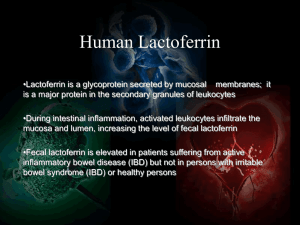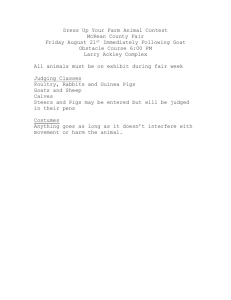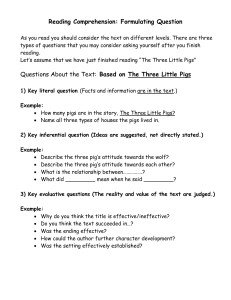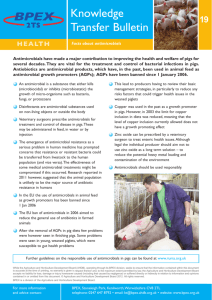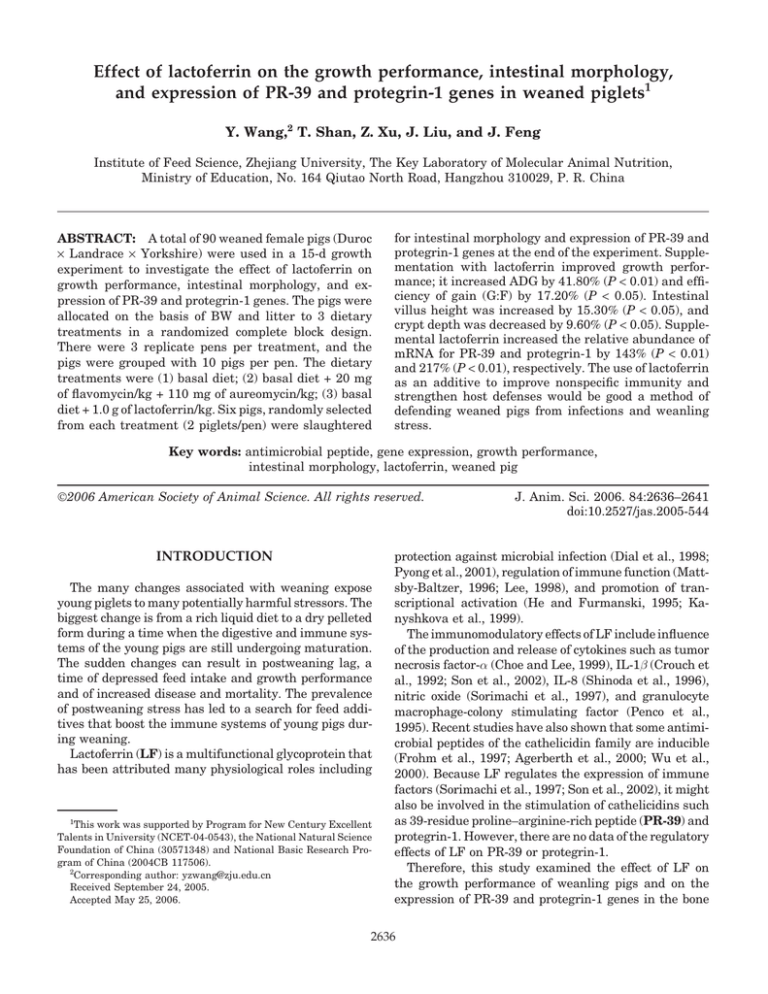
Effect of lactoferrin on the growth performance, intestinal morphology,
and expression of PR-39 and protegrin-1 genes in weaned piglets1
Y. Wang,2 T. Shan, Z. Xu, J. Liu, and J. Feng
Institute of Feed Science, Zhejiang University, The Key Laboratory of Molecular Animal Nutrition,
Ministry of Education, No. 164 Qiutao North Road, Hangzhou 310029, P. R. China
ABSTRACT: A total of 90 weaned female pigs (Duroc
× Landrace × Yorkshire) were used in a 15-d growth
experiment to investigate the effect of lactoferrin on
growth performance, intestinal morphology, and expression of PR-39 and protegrin-1 genes. The pigs were
allocated on the basis of BW and litter to 3 dietary
treatments in a randomized complete block design.
There were 3 replicate pens per treatment, and the
pigs were grouped with 10 pigs per pen. The dietary
treatments were (1) basal diet; (2) basal diet + 20 mg
of flavomycin/kg + 110 mg of aureomycin/kg; (3) basal
diet + 1.0 g of lactoferrin/kg. Six pigs, randomly selected
from each treatment (2 piglets/pen) were slaughtered
for intestinal morphology and expression of PR-39 and
protegrin-1 genes at the end of the experiment. Supplementation with lactoferrin improved growth performance; it increased ADG by 41.80% (P < 0.01) and efficiency of gain (G:F) by 17.20% (P < 0.05). Intestinal
villus height was increased by 15.30% (P < 0.05), and
crypt depth was decreased by 9.60% (P < 0.05). Supplemental lactoferrin increased the relative abundance of
mRNA for PR-39 and protegrin-1 by 143% (P < 0.01)
and 217% (P < 0.01), respectively. The use of lactoferrin
as an additive to improve nonspecific immunity and
strengthen host defenses would be good a method of
defending weaned pigs from infections and weanling
stress.
Key words: antimicrobial peptide, gene expression, growth performance,
intestinal morphology, lactoferrin, weaned pig
©2006 American Society of Animal Science. All rights reserved.
INTRODUCTION
The many changes associated with weaning expose
young piglets to many potentially harmful stressors. The
biggest change is from a rich liquid diet to a dry pelleted
form during a time when the digestive and immune systems of the young pigs are still undergoing maturation.
The sudden changes can result in postweaning lag, a
time of depressed feed intake and growth performance
and of increased disease and mortality. The prevalence
of postweaning stress has led to a search for feed additives that boost the immune systems of young pigs during weaning.
Lactoferrin (LF) is a multifunctional glycoprotein that
has been attributed many physiological roles including
1
This work was supported by Program for New Century Excellent
Talents in University (NCET-04-0543), the National Natural Science
Foundation of China (30571348) and National Basic Research Program of China (2004CB 117506).
2
Corresponding author: yzwang@zju.edu.cn
Received September 24, 2005.
Accepted May 25, 2006.
J. Anim. Sci. 2006. 84:2636–2641
doi:10.2527/jas.2005-544
protection against microbial infection (Dial et al., 1998;
Pyong et al., 2001), regulation of immune function (Mattsby-Baltzer, 1996; Lee, 1998), and promotion of transcriptional activation (He and Furmanski, 1995; Kanyshkova et al., 1999).
The immunomodulatory effects of LF include influence
of the production and release of cytokines such as tumor
necrosis factor-α (Choe and Lee, 1999), IL-1β (Crouch et
al., 1992; Son et al., 2002), IL-8 (Shinoda et al., 1996),
nitric oxide (Sorimachi et al., 1997), and granulocyte
macrophage-colony stimulating factor (Penco et al.,
1995). Recent studies have also shown that some antimicrobial peptides of the cathelicidin family are inducible
(Frohm et al., 1997; Agerberth et al., 2000; Wu et al.,
2000). Because LF regulates the expression of immune
factors (Sorimachi et al., 1997; Son et al., 2002), it might
also be involved in the stimulation of cathelicidins such
as 39-residue proline–arginine-rich peptide (PR-39) and
protegrin-1. However, there are no data of the regulatory
effects of LF on PR-39 or protegrin-1.
Therefore, this study examined the effect of LF on
the growth performance of weanling pigs and on the
expression of PR-39 and protegrin-1 genes in the bone
2636
2637
Effect of lactoferrin on weaned piglets
Table 1. Ingredient and chemical composition of the basal diet on an as-fed basis
Ingredient
Maize
Soybean meal
Wheat middling
Yeast
Fish meal
Stone meal
Dicalcium phosphate
Premix of the microelement1
Premix of vitamin2
Premix of growth promotant additive
Nutrition
composition
%
59.0
25.0
5.0
1.0
4.0
1.0
2.0
1.0
1.0
1.0
DE,3 MJ/kg
Crude protein, %
Calcium, %
Phosphorus, %
Lysine, %
Methionine, %
14.46
19.50
0.80
0.66
1.35
0.33
1
The mineral premix provided (per kilogram of feed): Fe (FeSO4ⴢ7H2O), 100 mg; Cu (CuSO4ⴢ5H2O), 6 mg;
Mn (MnSO4ⴢH2O), 4 mg; Zn (ZnSO4ⴢ7H2O), 100 mg; I (KI), 0.14 mg; and Se (Na2SeO3), 0.30 mg.
2
The vitamin premix provided (per kilogram of feed): vitamin A, 2,200 IU; vitamin D, 220 IU; vitamin E,
16 mg; vitamin K3, 0.50 mg; thiamine, 1.50 mg; riboflavin, 4.00 mg; pyridoxine, 2.0 mg; cobalamin, 0.020
mg; niacin, 20 mg; D-pantothenic acid, 12.00 mg; biotin, 0.08 mg; and folic acid, 0.30 mg.
3
DE was based on calculated values.
marrow. The effect of LF on the villus height and crypt
depth of small intestine was also studied.
MATERIALS AND METHODS
Materials
Lactoferrin was provided by the Institute of Feed Science, Zhejiang University, Hangzhou, China. Lactoferrin was isolated from milk (iron saturation is about 17%),
with a purity of approximately 90%. Flavomycin and
aureomycin were obtained from the National Institute
for the Control of Pharmaceutical and Biological Products (NICPBP, Beijing, China).
Animals and Experimental Design
All procedures were approved by the University of
Zhejiang Institutional Animal Care and Use Committee.
All the animal experiments were done according to the
guidelines for animal experiments at the National Institute of Animal Health.
A total of 90 weaned female pigs (Duroc × Landrace
× Yorkshire; 16 litters), with an average initial BW of
7.05 kg, were allocated on the basis of BW and litter to
3 dietary treatments in a randomized complete block
design for 15 d. There were 3 replicate pens per treatment, and pigs were grouped with 10 pigs per pen. The
dietary treatments were (1) basal diet, (2) basal diet +
20 mg of flavomycin/kg + 110 mg of aureomycin/kg, (3)
basal diet + 1.0 g of LF/kg. Diets were formulated to
meet or exceed NRC guidelines (1998) for 10- to 20-kg
pigs. The basal diet did not include antibiotics (Table 1).
Pigs were housed in temperature-controlled nursery
rooms and grouped in elevated pens with wire flooring.
Room temperature was maintained at 29°C. Feed and
water were available to the pigs ad libitum. The pigs
were weighed individually, and feed consumption per
pen was measured weekly throughout the study. Growth
performance results, such as ADG, ADFI, and G:F, were
subsequently determined for each pen. At the end of the
experiment, 6 pigs randomly selected from each treatment (2 piglets per pen) were slaughtered under general
anesthesia. Specimens from the middle part of the small
intestine were excised, flushed with physiological saline,
and fixed in 10% formalin for intestinal morphology.
Bone marrow samples from left femur of pigs were aseptically removed and immediately frozen in liquid nitrogen for RNA isolation.
Histomorphometry
For each intestinal sample, 3 cross-sections were prepared after staining with hematoxylin and eosin using
standard paraffin-embedding and staining procedures
(Xu et al., 2003). A total of 10 intact, well-oriented cryptvillus units were selected in triplicate for each intestinal
cross-section (30 measurements for each sample; total of
180 measurements per dietary treatment). Villus height
and crypt depth were determined using an image processing and analysis system (version 1, Leica Imaging
Systems Ltd., Cambridge, UK).
Total RNA Extraction
Total RNA was isolated from the bone marrow using
Trizol Reagent (Invitrogen Life Technologies, Carlsbad,
CA), according to the manufacturer’s instructions.
Briefly, after pulverization and homogenization of the
tissue, RNA was extracted from the homogenate with
chloroform and then precipitated by isopropanol. The
resulting pellets were dissolved in ultrapure water, and
the quantity and the quality of total RNA were measured
with a spectrophotometer at 260 and 280 nm.
Reverse Transcription
Two micrograms of total RNA and 2 L of random
primers (500 g/mL, Promega Corporation, Madison,
WI) were denatured at 70°C for 5 min. The following
2638
Wang et al.
Table 2. Specific primers for the PR-39, Protegrin-1, and β-actin genes
Gene
Accession
number
Primer
source
PR-39
L23825
Pig
Protegrin-1
X79868
Pig
β- actin
U07786
Pig
Length,
bp
Oligonucleotide sequence
5′ - CGCTGGTCACTGTGGCTTCT - 3′ (sense primer)
5′- CTGCTTCACTCGCCCATTCT - 3′ (antisense primer)
5′ - CCGTGCTTCGTGCTGTGGA -3′ (sense primer)
5′ - TGCCGTCGCAACCGTCAT -3′ (antisense primer)
5′ - CGGGACCTGACCGACTACCT - 3′ (sense primer)
5′ - GGCCGTGATCTCCTTCTGC - 3′ (antisense primer)
components were added in order: 5 L of 5× Reaction
Buffer (250 mM Tris-HCl, pH 8.3; 375 mM KCl; 15 mM
MgCl2; 50 mM dithiothreitol), 2 L of dNTP mix (10 mM
each of dATP, dCTP, dGTP, and dTTP), 1 L of M-MLV
reverse transcription (200 U/L, Promega), 0.5 L of
rRNasin ribonuclease inhibitor, and nuclease-free water
to a final volume of 25 L. The reaction was gently mixed
by flicking the tube and was then incubated at 37°C for
60 min.
Determination of the Number of PCR Cycles
The appropriate number of cycles was established so
that the amplification product was not only still in the
exponential range but also clearly visible and quantifiable on an agarose gel. One microliter of cDNA solution,
obtained by reverse transcription total RNA, was used
as the template for PCR amplification in a total volume
of 50 L. The optimum PCR primer concentration, Mg2+
concentration, and annealing temperature that would
result in linear amplification of each transcript were
determined in a preliminary experiment (data not
shown). The PCR assay mixture contained the following
components: 37.5 L of nuclease-free water, 5 L of 10×
PCR reaction buffer, 3 L of MgCl2 (25 M), 1 L of
dNTP mix, 1 L of sense primer (20 M), 1 L of antisense primer (20 M), and 0.5 L of Taq DNA polymerase (2 U/L, Promega). All subsequent amplification reaction steps were performed using a GeneAmp PCR System 9600 (Perkin-Elmer, Fremont, CA).
The PCR profiles for PR-39, protegrin-1, and β-actin
consisted of denaturation at 94°C for 2 min, followed by
a varied number of cycles with denaturation at 94°C for
45 s, annealing at 58°C for 45 s, and extension at 72°C
for 50 s, and a final extension at 72°C for 10 min. Oligonucleotide primers (ShangHai Sangon Biological Engineering Technology and Service Company, ShangHai,
China) specific for porcine PR-39, protegrin-1, and βactin were based on known sequences deposited in GenBank and are listed in Table 2. The PCR amplification
products were predicted to be 285 bp for PR-39, 355 bp
for protegrin-1, and 411 bp for β-actin. The appropriate
number of cycles for each target was determined by
assaying amplification products after 23, 25, 27, 29, 31,
33, and 35 cycles, and all other variables remained
constant.
Polymerase chain reaction products were seen for PR39 (285 bp), protegrin-1 (355 bp), and β-actin (411 bp)
285
355
411
after amplification of bone marrow cDNA using pigletspecific primers. Twenty-nine cycles of amplification
were sufficient to allow visualization of products before
a plateau was reached. Consequently, 29 cycles were
used for the semiquantitative analysis of PR-39, protegrin-1, and β-actin.
Reverse-Transcription-PCR Assay
The relative concentrations of PR-39 and protegrin-1
mRNA in the bone marrow of different treatment groups
were determined by semiquantitative reverse-transcription-PCR (Marone et al., 2001). An equal volume of PR39, protegrin-1, and β-actin cDNA was amplified in 29
cycles with the cycling parameters used during cycle
number optimization.
A 5-L portion of each PCR product was subjected
to electrophoresis on a 1% agarose gel with ethidium
bromide. Polymerase chain reaction products were normalized according to the amount of β-actin detected in
the same cDNA sample. Electrophoresis band intensities
of the PCR products in agarose gels were quantified
using Image Master VDS software (Amersham Pharmacia Biotech, Uppsala, Sweden). Mean relative abundance of mRNA for PR-39 and protegrin-1 were normalized against relative abundance of mRNA for β-actin and
presented as absolute integrated optical density.
Data Analysis
Data were analyzed as a randomized complete block
using the GLM procedure (SAS Inst. Inc., Cary, NC). A
pen of pigs served as the experimental unit for all data.
The relative abundance of mRNA for PR-39 and protegrin-1 in piglet bone marrow after different treatments
was compared on the basis of the PR-39/β-actin and
protegrin-1/β-actin ratios. Differences between treatments were analyzed according to the Bonferroni/Dunn
method (Duncan, 1955). Effects were considered significant at P < 0.05.
RESULTS
Growth Performance
Growth performance was improved by LF supplementation (Table 3). Compared with the control, LF treatment increased the ADG by 41.80% (P < 0.01) and increased the efficiency of gain (G:F) by 17.20% (P < 0.05).
Effect of lactoferrin on weaned piglets
2639
Table 3. Effect of lactoferrin on growth performance of
weaning pigs1
Item
Control
Antibiotic
Lactoferrin
SEM
Ending BW, kg
ADG, g
ADFI, g
G:F
10.4
239.7a
275.6a
0.87a
11.2
293.4ab
308.1ab
0.95ab
11.8
340.0b
333.1b
1.02b
0.54
20.49
25.40
0.04
a,b
Means within a row with different superscript letters differ (P
< 0.05).
1
Each mean represents 30 pigs. Control = basal diet; Antibiotic =
basal diet + 20 mg of flavomycin/kg + 110 mg of aureomycin/kg;
Lactoferrin = basal diet + 1.0 g of lactoferrin/kg.
Effect of LF on the Small Intestinal Morphology
Compared with the control, supplementation with LF
increased villous height by 15.30% (P < 0.05) and decreased crypt depth by 9.60% (P < 0.05; Table 4). Supplementation with antibiotic did not change intestinal villus
height or crypt depth (P > 0.05; Table 4).
Effect of LF on the Gene Expression of PR-39
Supplemental LF and antibiotic significantly increased the relative abundance of PR-39 by 143% (P <
0.01) and 151% (P < 0.01), respectively, compared with
the control group (Figure 1). The difference between LF
and antibiotic treatments was not significant.
Effect of LF on the Gene Expression of Protegrin-1
Supplemental LF and antibiotic increased the relative
abundance of protegrin-1 by 217% (P < 0.01) and 147%
(P > 0.05), respectively, compared with the control group
(Figure 2). No difference was observed between the LF
and antibiotic treatment groups.
DISCUSSION
At weaning, the digestive system of piglets must adapt
to a dry pellet diet instead of liquid milk from the sow.
As a consequence, the newly weaned pig is subject to
a myriad of stressors that contribute to outbreaks of
diarrhea (Pluske et al., 1997) and depressed feed intake
and growth (Okai et al., 1976). The results of this study
reveal that supplemental LF can effectively increase the
Table 4. Effect of lactoferrin on intestinal villus height
and crypt depth1
Item
Control
Antibiotic
Lactoferrin
SEM
Villus height, m
Crypt depth, m
213.1a
235.3a
229.1ab
233.0ab
245.6b
212.7b
7.06
6.64
a,b
Means within a row with different superscript letters differ (P
< 0.05).
1
Each mean represents 6 pigs. Control = basal diet; Antibiotic =
basal diet + 20 mg of flavomycin/kg +110 mg of aureomycin/kg; Lactoferrin = basal diet + 1.0 g of lactoferrin/kg.
Figure 1. Effect of lactoferrin on the expression of PR-39
in the bone marrow of weanling pigs. A) Electrophoresis
results of reverse-transcription-PCR for PR-39 and β-actin
in bone marrow. Lane 1: control group; lane 2: antibiotic
group; lane 3: lactoferrin (LF) group. B) The integrated
optical density (IOD) ratio of each band of PR-39 and βactin for the control group, antibiotic group, and LF
group. Densitometric analysis of porcine PR-39 gene expression was normalized to β-actin and shown as PR39/β-actin ratios. Each column represents the mean of 6
individual pigs ± SEM. *P < 0.05.
ADG and G:F. The reason for this improved growth performance may be related to the functions of LF. Lactoferrin is an important component of the nonspecific immune
system and has antimicrobial, antifungal, and antiviral
properties (van der Strate et al., 2001). Our results
showed that LF could improve small intestinal morphology and increase PR-39 and protegrin-1 gene expression
to some extent, promoting digestion and absorption of
nutrition, regulating and enhancing the immunity of
2640
Wang et al.
Figure 2. Effect of lactoferrin on the expression of protegrin-1 in the bone marrow of weanling pigs. A) Electrophoresis results of reverse-transcription-PCR for protegrin-1 and β-actin in bone marrow. Lane 1: control group;
lane 2: antibiotic group; lane 3: lactoferrin (LF) group. B)
The integrated optical density (IOD) ratio of each band
of protegrin-1 and β-actin for the control group, antibiotic
group, and LF group. Densitometric analysis of porcine
protegrin-1 gene expression was normalized to β-actin
and shown as protegrin-1/β-actin ratios. Each column
represents the mean of 6 individual pigs ± SEM. *P < 0.05.
neonatal pigs and thereby partially accounting for the
improved growth during weaning.
The structure of the intestinal mucosa can reveal some
information on gut health. Changes in intestinal morphology such as shorter villus and deeper crypts have
been associated with the presence of toxins (Xu et al.,
2003). After weaning, villus height is generally reduced
and crypt depth increased, which are primarily related
to reduced feed intake immediately after weaning
(Pluske et al., 1996). In the current study, increases in
villus height and decreases in crypt depth at the small
intestinal mucosa of the pigs supplemented with LF were
observed. Pigs supplemented with LF had greater villus
height and lower crypt depth at the small intestinal
mucosa, which may contribute to improved growth performance.
Antimicrobial peptides are gene-encoded natural antibiotics with potent and broad antimicrobial capabilities
that function as a first line of defense in the innate
immunity of the host (Ganz, 2002; Lehrer and Ganz,
2002; Zasloff, 2002). A large family of antimicrobial peptides, the cathelicidins, is present in humans, mice, and
guinea pigs, and is particularly well represented in domestic animals (Zanetti et al., 2000; Zhang et al., 2000;
Ramanathan et al., 2002). Cathelicidin genes contain 4
exons and a 5′-flanking region with clusters of potential
transcriptional regulatory motifs such as nuclear factorκB (NF-κB), nuclear factor-IL-6 (NF-IL-6), IL-6-response
element (IL-6-RE), selective promoter factor 1 (Sp1), activating protein 2 (Ap-2), and lipopolysaccharide (Wu et
al., 2002; Ramanathan et al., 2002). Moreover, it has
been shown that some cathelicidins, such as PR-39, are
inducible (Agerberth et al., 2000; Wu et al., 2000). Recent
research shows that LF can act as a transcription factor
and regulator of granulopoiesis and DNA synthesis in
some cell types (Kanyshkova et al., 2001). It has been
suggested that LF is a member of a novel class of transcription factors that are secreted from 1 cell, taken up
by a target cell, and are transported to the nucleus where
they bind specific DNA sequence to activate transcription (He and Furmanski, 1995). Therefore, the focus of
the current study was to examine the effect of LF on the
gene expression of PR-39 and protegrin-1 in weanling
pigs. The finding that supplemental LF significantly improves the relative abundance of mRNA for PR-39 and
protegrin-1 suggests that LF can regulate the expression
of the 2 cathelicidins in the bone marrow of weanling
piglets.
Whether the effect of LF on the gene expression of
PR-39 and protefrin-1 is direct or not is a subject for
further study. However, it has been shown that LF binds
to specific DNA consensus sequences and can upregulate
expression of reporter genes (Garre et al., 1992). This
implies that exogenous LF can be internalized and translocated to the nucleus (Brock, 1995; Fleet, 1995). The
current study showed that LF could regulate transcription of IL-1β gene and may also regulate transcription
of other natural genes containing the LF binding sites
(Son et al., 2002). Therefore, a part of LF might be absorbed intact, affect bone marrow mRNA abundance,
and improve gene expression of the 2 antimicrobial peptides. Antibiotic affected gene expression of PR-39 but
did not significantly affect protegrin-1 gene expression.
Components of the gut mucosal barrier and nonspecific immune factors, such as PR-39, are more important
to growth and immunity of weanling pigs in the growing
phase (Bosi et al., 2003). Lactoferrin is an important
component of the nonspecific immune system and has
been attributed many physiological roles, such as serving as a regulator of iron metabolism, a nonspecific mediator of inflammation and a component of the host defense
system against infection. It is also well known that antimicrobial peptides are important and effective compo-
Effect of lactoferrin on weaned piglets
nents of innate immunity. Using LF to stimulate the
expression of antimicrobial peptides and improve the
nonspecific immune system to strengthen the host defenses is a good method of protecting the weanling pigs
from infection and weanling stress. Increased production
of the antimicrobial peptides may also contribute to improved growth performance. However, further studies
are needed to determine if LF regulates other antimicrobial peptides and to find the specific LF binding sites in
these peptides.
This study showed that supplemental lactoferrin could
affect the small intestinal morphology, effectively stimulate expression of PR-39 and protegrin-1, improve nonspecific immunity, and consequently, improve the
growth performance of weaned pigs. Further work is
needed to characterize the specific lactoferrin binding
sites in the antimicrobial peptides. The molecular details
would provide information needed for the use of lactoferrin in regulating peptide expression and improving nonspecific immunity in pigs as protection against infections
and weanling stress.
LITERATURE CITED
Agerberth, B., J. Charo, J. Werr, B. Olsson, F. Idali, L. Lindbom, R.
Kiessling, H. Jörnvall, H. Wigzell, and G. H. Gudmundsson. 2000.
The human antimicrobial and chemotactic peptides LL-37 and
α-defensins are expressed by specific lymphocyte and monocyte
populations. Blood 96:3086–3093.
Bosi, P., C. Gremokolini, and P. Trevisi. 2003. Dietary regulations of
the intestinal barrier function at weaning. Asian-australas. J.
Anim. Sci. 16:596–608.
Brock, J. 1995. Lactoferrin: A multifunctional immunoregulatory protein. Immunol. Today 16:417–419.
Choe, Y., and S. Lee. 1999. Effect of lactoferrin on the production of
tumor necrosis factor-a and nitric oxide. J. Cell. Biochem.
76:30–36.
Crouch, S. P. M., K. J. Slater, and J. Fletcher. 1992. Regulation of
cytokine release from mononuclear cells by the iron-binding protein lactoferrin. Blood 80:235–240.
Dial, E. J., L. R. Hall, H. Serna, J. J. Romero, J. G. Fox, and L. M.
Lichtenberger. 1998. Antibiotic properties of bovine lactoferrin
on Helicobacter pylori. Dig. Dis. Sci. 43:2750–2756.
Duncan, D. B. 1955. Multiple range and multiple F test. Biometrics
11:1–42.
Fleet, J. C. 1995. A new role for lactoferrin: DNA binding and transcription activation. Nutr. Rev. 53:226–231.
Frohm, M., B. Agerberth, G. Ahangari, M. Stahle-Backdahl, S. Liden,
H. Wigzell, and G. H. Gudmundsson. 1997. The expression of the
gene coding for the antibacterial peptide LL-37 is induced in
human keratinocytes during inflammatory disorders. J. Biol.
Chem. 272:15258–15263.
Ganz, T. 2002. Antimicrobial polypeptides in host defense of the respiratory tract. J. Clin. Invest. 109:693–697.
Garre, C., G. Bianchi-Scarra, M. Sirito, M. Musso, and R. Ravazzolo.
1992. Lactoferrin binding sites and nuclear localization in K562
(S) cells. J. Cell. Physiol. 153:477–482.
He, J., and P. Furmanski. 1995. Sequence specificity and transcriptional activation in the binding of lactoferrin to DNA. Nature
373:721–724.
2641
Kanyshkova, T. G., V. N. Buneva, and G. A. Nevinsk. 2001. Lactoferrin
and its biological functions. Biochemistry (Moscow) 66:1–7.
Kanyshkova, T. G., D. V. Semenov, V. N. Buneva, and G. A. Nevinsky.
1999. Human milk lactoferrin binds two DNA molecules with
different affinities. FEBS Lett. 451:235–237.
Lee, W. L. 1998. The protective effects of lactoferrin feeding against
endotoxin lethal shock in germ-free piglets. Infect. Immun.
66:1421–1426.
Lehrer, R. I., and T. Ganz. 2002. Defensins of vertebrate animals.
Curr. Opin. Immunol. 14:96–102.
Marone, M., S. Mozzetti, D. D. Ritis, L. Pierelli, and G. Scambia. 2001.
Semiquantitative RT-PCR analysis to assess the expression levels
of multiple transcripts from the same sample. Biol. Proced. Online
3:19–25.
Mattsby-Baltzer, I. 1996. Lactoferrin or a fragment thereof inhibits
the endotoxin-induced interleukin-6 response in human monocytic cells. Pediatr. Res. 40:257–262.
Okai, D. B., F. X. Aherne, and R. T. Hardin. 1976. Effects of creep
and starter composition on feed intake and performance of young
pigs. Can. J. Anim. Sci. 56:573–586.
Pluske, J. R., I. H. Williams, and F. X. Aherne. 1996. Villous height
and crypt depth in piglets in response to increases in the intake
of cows’ milk after weaning. Anim. Sci. 62:145–158.
Pyong, W. P., B. P. Gerald, T. H. Michael, and M. Bernfield. 2001.
Exploitation of syndecan-1 shedding by Pseudomonas aeruginosa
enhances virulence. Nature 411:98–102.
Pluske, J. R., D. J. Hampson, and I. H. Williams. 1997. Factors influencing the structure and function of the small intestine in weaned
pig: A review. Livest. Prod. Sci. 51:215–236.
Ramanathan, B., E. G. Davis, C. R. Ross, and F. Blecha. 2002. Cathelicidins: Microbicidal activity, mechanisms of action, and roles in
innate immunity. Microbes Infect. 4:361–372.
Shinoda, I., M. Takase, Y. Fukuwatari, S. Shimamura, M. Koller, and
W. Konig. 1996. Effects of lactoferrin and lactoferricin on the
release of interleukin 8 from human polymorphonuclear leukocytes. Biosci. Biotechnol. Biochem. 60:521–523.
Son, K. N., J. B. Park, C. K. Chung, D. K. Chung, D. Y. Yu, K. K. Lee,
and J. Kim. 2002. Human lactoferrin activates transcription of
IL-1β gene in mammalian cells. Biochem. Biophys. Res. Commun.
290:236–241.
Sorimachi, K., K. Akimmoto, Y. Hattori, T. Ieiri, and A. Niva. 1997.
Activation of macrophages by lactoferrin: Secretion of TNF-alpha,
IL-8 and NO. Biotechnol. Biochem. 60:521–523.
van der Strate, B. W. A., L. Beljaars, G. Molema, M. C. Harmsen, and
D. K. F. Meijer. 2001. Antiviral activities of lactoferrin. Antiviral
Res. 52:225–239.
Wu, H., C. R. Ross, and F. Blecha. 2002. Characterization of an upstream open reading frame in the 5′ untranslated region of PR39, a cathelicidin antimicrobial peptide. Mol. Immunol. 39:9–18.
Wu, H., G. Zhang, J. E. Minton, C. R. Ross, and F. Blecha. 2000.
Regulation of cathelicidin gene expression: Induction by lipopolysaccharide, interleukin-6, retinoic acid, and Salmonella enterica
serovar typhimurium infection. Infect. Immun. 68:5552–5558.
Xu, Z. R., C. H. Hu, M. S. Xia, X. A. Zhan, and M. Q. Wang. 2003. Effects
of dietary fructooligosaccharide on digestive enzyme activities,
intestinal microflora and morphology of male broilers. Poult. Sci.
82:648–654.
Zanetti, M., R. Gennaro, M. Scocchi, and B. Skerlavaj. 2000. Structure
and biology of cathelicidins. Adv. Exp. Med. Biol. 479:203–218.
Zasloff, M. 2002. Antimicrobial peptides in health and disease. N. Engl.
J. Med. 347:1199–1200.
Zhang, G., C. R. Ross, and F. Blecha. 2000. Porcine antimicrobial
peptides: New prospects for ancient molecules of host defense.
Vet. Res. 31:277–296.

